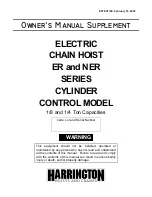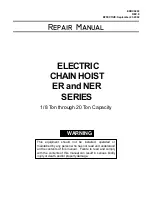
https://www.XPOtool.com
Item 64174, 64175
Page 6
The Tool Experts
02 2023-1
•
before the first use,
•
before any re-use after placing out of operation,
•
after major modifications,
•
at least once a year by a qualified person.
Attention!
The actual operation conditions (e.g., operation in a galvanising site) might stipulate shorter
checking intervals.
•
Any repair can only be performed by a qualified workshop and with original spare parts. The
check (essentially consisting of a visual and functional test) must cover the completeness and
functionality of all safety devices as well as the condition of the device, the suspension, equip-
ment, and supporting structure with regard to damage, wear, corrosion, or other modifications.
•
The initial commissioning and the recurring tests must be documented (e.g., in the factory cer-
tificate).
•
If necessary, evidence of the results of the tests and corresponding repairs must be provided.
If the chain hoist (from 1-t load capacity) is mounted on or in a trolley and the chain hoist is used
to move a raised load in one or more directions, the system is considered a crane and further
tests must be carried out as required.
•
Paint damage should be touched up to avoid corrosion. All joints and sliding surfaces should be
lightly lubricated. If the device is heavily soiled, it must be cleaned.
•
After 10 years at the latest, the device must undergo a general overhaul. In particular, the di-
mensions of the load chain, load hook, and upper hook must be checked.
Attention!
After replacing components, a check by a qualified person is mandatory!
Inspection of the load chain (according to DIN 685–5)
•
Load chains must be checked for mechanical damage at regular intervals, but no later than after
50 hours of operation. Check the load chain for sufficient lubrication and for external defects,
deformation, superficial cracks, and signs of wear and corrosion.
•
Round steel chains must be replaced if the original nominal thickness d at the chain link with
the greatest wear has been reduced by more than 10
% or if the chain has extended by 5
%
over a part p
n
or by 3
% over 11 parts (11 x p
n
).
Maintaining the load chain
•
In most cases, wear and tear of the chain in the pivot points is due to insufficient maintenance
of the chain. To ensure optimal lubrication of the link contact points, lubricate the chain at regular
intervals appropriate to the application with a penetrating lubricant (e.g., gear oil).
•
In environments where abrasive materials such as sand etc. are present, a dry lubricant, e.g.,
PTFE spray, should be used. Proper lubrication can increase the life span of the load chain by
20 to 30 times compared to an unmaintained chain.
•
When lubricating the chain, make sure that the chain is not under load so that the oil can reach
the contact points of the chain links that are at risk of wear. The parts of the chain links touching
each other must always be covered with lubricant, otherwise increased wear of the chain will
occur.
•
It is not sufficient to lubricate the chains on the outside, as this does not guarantee that a lubri-
cating film can build up at the contact points.
•
If the lifting path of the chain remains the same, the switching range from lifting to lowering must
be checked in particular.
•
It is important to ensure that the load chain is lubricated along its entire length, including the
part of the chain in the hoist housing.
•
Dirty chains are cleaned with petroleum or a similar cleaning agent.
•
Never heat the chain.
•
When lubricating the chain, also check its wear.















